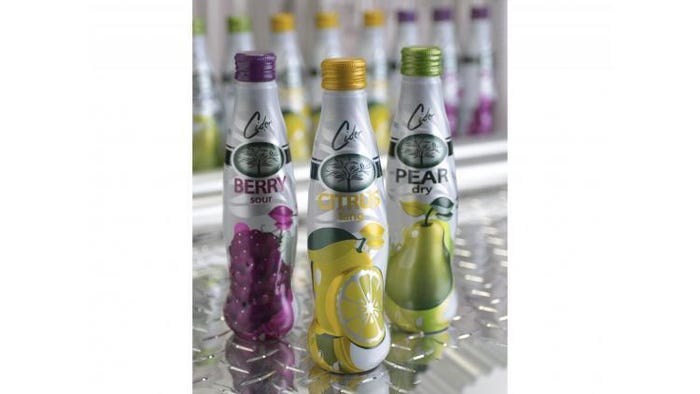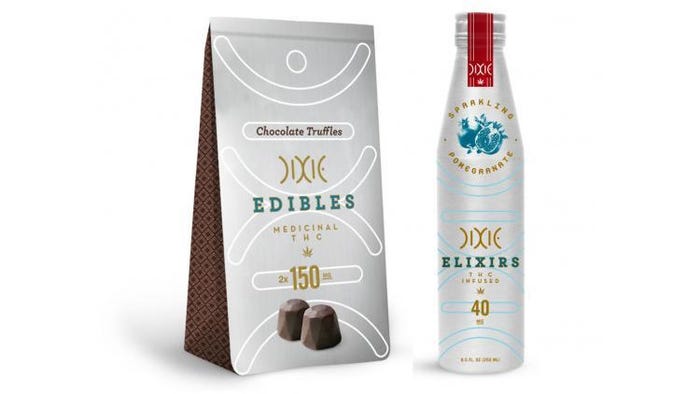Top 10 packaging design editorials of 2017
Great packaging design is the common denominator for articles about Kellogg’s on-the-go snacks, cannabis, millennials, smart packaging, influential kids, shaped aluminum and the “beauty” market. As we continue our end-of-the-year review, we now present our Top 10 list of packaging design-related items for the year based on page views at PackagingDigest.com.
One qualification: Packaging design-related articles that appear in other top-article lists are not duplicated here. For example, “Bag-in-box bulk water debuts in U.S.” definitely details the AquaViBox packaging design but because it hits #5 on our list of “7 best-read food and beverage packaging articles of 2017,” it does not show up in this compilation.
We start our countdown with…

#10. New tech reshapes aluminum beverage bottles
Aluminum beverage bottles reached an apex around 2005 with the introduction of reclosable, shaped designs for Coke and Jolt soda brands. It has taken another decade to improve on that with technology that creates asymmetric shapes in register with printing.
The proprietary, patented uShape technology from Montebello Packaging helps brands stand out with a unique shape that provides powerful iconic brand equity. The technology allows Montebello Packaging to asymmetrically shape an aluminum bottle with flutes, embossing, debossing and various fine details.
NEXT: Kellogg’s kits packed for on-the-go snacking

#9. Kellogg’s kits packed for on-the-go snacking
Packaging for Kellogg’s new Keebler Town House Pita and Flatbread Cracker and Hummus Snack Boxes delivers a mess-free and utensil-free snacking experience for busy, on-the-go consumers looking for a quick bite to tide them over.
In this Packaging Digest exclusive interview, Tom Hanel, Kellogg’s lead packaging engineer, explains how the single and three-count multipack snack boxes also satisfied supply chain needs. “Both formats were designed to deliver through traditional Kellogg storage and distribution systems, though the packaging materials selected also protect the integrity of the crackers and hummus when placed in deli cases and refrigerators.”
Read more about the packages’ sustainability impact by clicking the link in the headline above.
NEXT: Cannabis brand Toast uses elegant packaging to convey luxury

#8. Cannabis brand Toast uses elegant packaging to convey luxury
In the first of three cannabis packaging articles to make our list, we are introduced to Toast, a luxury brand of smokable marijuana. The “Slices” (which resemble cigarettes) are elegantly presented in a rigid box with an Art Deco design, embossing, foil stamping and metallic inks.
Gabrielle Rein, chief creative officer at Toast and creative director at Viceroy Creative , which developed the structural and graphic packaging design, talks about how the high-quality paperboard box is a “meticulously crafted” unisex design that skews feminine.
“We took a very high-quality, crafted approach to creating something that was enjoyable to use,” Rein says. “The package is recyclable. Or you may want to just hold onto it for a secondary use! It has a magnetic closure.”
She also brags about the brand’s shelf appeal. “Customers consistently enter the store and are immediately drawn to Toast due to the beautiful packaging, which stands out on the shelf along with the custom-designed store displays.”
NEXT: 4 areas where smart packaging excels

#7. 4 areas where smart packaging excels
Packaging aficionado and author Ian Lifshitz sees great potential in near-field communication (NFC) technology for today’s smart packaging to help brands connect with consumers in the store and at home with information, convenience and rewards. Lifshitz, vp of sustainability and stakeholder relations for the Americas for Asia Pulp & Paper Group (APP), identifies these four ways smart packaging can bring value:
1. Content—What more do consumers need or want to know?
2. Replenishment—Is the product almost gone?
3. Expiration—How fresh?
4. Authentication—Is this the real thing?
NEXT: The Millennial Factor: How a generation of consumers is transforming today’s packaging landscape

#6. The Millennial Factor: How a generation of consumers is transforming today’s packaging landscape
The largest and most influential generation in history, millennials wield significant purchasing power. Ideas for how brands can cater to these consumers’ demands for innovation and uniqueness were much appreciated over the last couple years, including back in April 2016 when this article was published.
Author—and a millennial herself—Briana Long of PMMI, The Assn. of Packaging and Processing Technologies, points to five ways brand owners can use packaging to market to a generation attuned to instant gratification:
• Personalization
• Customization
• Affordability
• Branded
• Connected
NEXT: 2016 parade of new packages showcases great design

#5. 2016 parade of new packages showcases great design
For ideas and inspiration, we present all the new packages published on PackagingDigest.com in 2016. This sortable, searchable, downloadable database contains links, photos and summaries of more than 80 packages. From bottles to pouches and cups to cans, these commercialized packages all have a great design story to tell.
[We've already started to compile our 2017 articles in an Excel document for an early-January posting.]
NEXT: Honest Marijuana chooses cans to protect cannabis from light, moisture and oxidation

#4. Honest Marijuana chooses cans to protect cannabis from light, moisture and oxidation
A food-grade tin can is an unusual choice for marijuana buds, but it certainly protects the product from getting crushed, from the damaging effects of light and moisture, and from oxidation. The package—which also has a child-resistant overcap—preserves freshness and maintains product aroma.
Although this article was posted in August 2016, it remains a favorite.
NEXT: Marijuana packaging: Beyond the baggie

#3. Marijuana packaging: Beyond the baggie
This landmark April 2014 article analyzed packaging possibilities for recreational cannabis, which was just emerging as a growth market in Colorado and Washington states, as well as for medical marijuana. Now, seven states and the District of Columbia (D.C.) have legalized recreational use.
We looked at edibles, supply chain, safety, regulations, labeling, graphics, pilferage and more. At the time this was written, freelance writer Kate Bertrand Connolly made two predictions, both of which have subsequently materialized:
“First, the thicket of rules and regulations surrounding marijuana packaging will grow denser. And second, the fledgling cannabis industry will continue to roll out the green carpet for packaging suppliers, designers, advisors and consultants.”
NEXT: The undeniable influence of kids
#2. The undeniable influence of kids
Bill Goodwin, founder of Goodwin Design Group, has many clients who are leading marketers, including Disney, Crayola, Hasbro, Mattel and Toys R Us. So he understands how empowered children are when it comes to making buying decisions for their entire household—and how to leverage that empowerment.
Back in October 2013, Goodwin answered key questions about the influential Generation Z—insight that obviously still resonates with packaging professionals to put this four-year-old article at #2 on our list. In this piece, he outlines:
Why consider kids?
How do kids relate to brands?
What tools should be considered?
Why is transformation required?
Evergreen reading…even as Generation Z reaches adulthood.
NEXT: 5 advances and packaging trends in the beauty universe

#1. 5 advances and packaging trends in the beauty universe
In this highly annotated article, author and marketing/design expert Dr. Pascale Gauthier studies the beauty market to identify five ways it is evolving—and what that means to packaging:
1. Combining form and function—“Design encompasses ease of use and product performance—and it is essential for cosmetics.”
2. Helpful tools—brushes, sponges and other application tools.
3. Crossover ideas—“Packaging from different fields (food, pharmacy) could deliver innovative systems for use with cosmetics.”
4. New movements—from nail art to make-up for hair and new sampling packs.
5. Impact of the digital era—from ecommerce to blogs or “vlogs” (video blogs) that stimulate sales to “click and reserve,” a hybrid trade between physical sales and web.
She concludes, “The cosmetic industry is a real innovative factory always in flux for offering dreams and pleasures to its user, and helping to create an ideal world of beauty. Efficiency should not be forgotten and all the new active products and ingredients, as well as new materials and forms, are perfectly represented in the cosmetic sector.
“Preserving and improving this beauty capital that is so important in our image-centric world is a huge challenge that seems to be brilliantly successful partly because of innovative packaging.”
Much more to come in 2018 on design trends and new packages. Stay tuned.
About the Author(s)
You May Also Like




